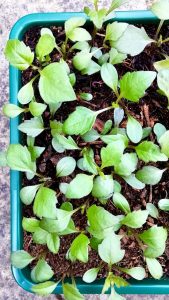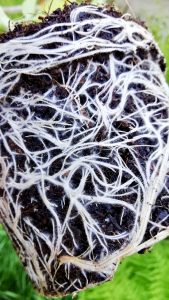Are you impatient for the phase-out of peat, or anxious about its implications for your garden and greenhouse? With the right advice, we can all look forward to a peat-free future.
Peat-based compost – along with the ecological destruction that follows in its wake – is in the departure lounge. There is no turning back.
From 2024 (parliamentary procedures permitting), sowing and potting composts – specialist and multipurpose, and any other products sold in plastic bags that have traditionally contained peat – will no longer be sold to gardeners. Once the ban (in England, but to be mirrored elsewhere) finally arrives, it will be illegal for retailers to sell them. And not before time.

Commercial horticulture still has a few more years to make the switch to peat-free. A general ‘exemption’ will apply for all growers (essentially those who grow plants in large numbers to stock retailers’ shelves) up until 2026, and then for specialist growers until 2030. This means that some plants grown in compost containing peat will still be on sale after bagged peat-containing compost no longer is. A permanent exemption will apply for a limited number of rare plants of conservation importance that can only be grown using peat.
Even the grumbling laggards of an industry whose claim to ‘greenness’ often rings hollow will eventually have to join a renewable, nature- and climate-friendly peat-free future (they can learn fast from growers who’ve been peat-free for 20-odd years already).
Finally, we can bury decades of mendacious pro-peat myths and baseless opinions, media misinformation, business and political filibustering, and failed voluntarism. Their simple headstone will annul the throwaway yet pernicious ‘all peat-free compost is rubbish’ lie: Just. Not. True.
Carping will inevitably continue – the end of gardening is nigh (as if!), and how tragic it is that we no longer have ‘freedom of choice’ (having whatever we want, whenever we want it, is so ecologically passé). And yes, the doubt-sowing ‘rubbish’ lie will rumble on, even as the very last bag of peat-containing compost hits a car boot, seconds before the ban kicks in. But let’s leave the argy-bargy behind and move on.
As peat bows out, communicators like me need to give clear, down-to-earth, transition-savvy advice on how every gardener, sage or newbie, can win at growing their plants peat-free, then relish a beautiful and productive greenhouse, garden or allotment. Spoiler alert: it ain’t difficult. Here’s my tuppence-worth.
Buy the best

There will be blips, but ‘you get what you pay for’ holds firm when buying peat-free. Prices are rising; the days of three-bags-for-£12 are gone (no one paid the true environmental cost of mining peat to turn it into compost). Expect to pay £5 to £10 for 40/50 litres of a quality, proven, consistent and reliable peat-free mix. Try to think ‘it’s an investment in my garden’ rather than ‘blimey, that’s expensive’; good, professional-grade mixes work well because of the research and investment, quality raw materials, testing and trialling that goes into them.
Investing in a bag of quality peat-free is an antidote to the danger of disappointment lurking in cheaper bandwagon products. Remember that ‘peat-free’ on a bag is not a quality mark; some peat-frees – usually the cheap ones – are rubbish in a plastic bag. And until the ban comes in, if it doesn’t say it’s peat-free, it probably isn’t.
Tracking down quality mixes can be tricky. Online stockist locators can help, as can googling for local suppliers (phone ahead if it’s a special trip). Ordering weighty compost from online retailers can rack up the cost – you could end up paying more for delivery than the product itself (with no idea of how fresh it is).
Fresh plays it safe
Buying fresh peat-free, especially in spring, is crucial. Give faded, busted, torn and water-sodden bags a miss. Peat-free composts are by their nature microbially alive, so they react to how long they’ve been around and how they’re stored. I don’t buy compost from retailers who keep theirs outside all year round; wise businesses keep their compost under cover, and their customers happy. If you’ve no choice, be sure to take your bags from lower down in a stack, which are less likely to be rain-soaked.
At home, fold the tops of opened bags over and store them in a dry, cool place, out of the sun.
Budget wisely, triage
Money is tight right now, but gardening brings priceless joy. If you can only afford a few bags of top-quality peat-free, triage your plans for the growing season and use it where it will have the biggest impact. Use it for tasks into which you’ve already sunk some cash: seed-sowing, potting up young plug plants, and potting summer-flowering bulbs.
For sowing, quality compost can be made to go even further by going half and half: half-fill a tray or pot with mature leafmould (or pre-used compost), then add your peat-free on top and sow into that.
Don’t use fresh, quality compost for filling big containers – there might be a less pricey but adequate peat-free available for that (or you could mix your own).
Compare and contrast

Genuinely unnerved at the thought of switching to peat-free? Then give both a try this spring and summer by sowing and potting some of the same plants into your trusty peat-based compost and a quality peat-free mix. Grow them – literally – side by side in your greenhouse and see how they do (you might be surprised how little they differ). Tap them out of their pots to see how the roots are doing, and do lots of comparing, poking and observing.
Look, touch, lift, learn
Observing how plants grow in a top-quality peat-free is one thing, but it’s useful to get more hands-on. Peat-free mixes respond a little differently, especially to watering. What looks like dry compost might only be surface-deep. You can test how damp the compost is by pressing a finger into the surface. If it’s moist, and the pot feels ‘heavy’ when you lift it, it doesn’t need watering. Green ‘slime’ on compost can also be a sign of overwatering. High-peat composts tend to dry out quite quickly, so comparing plants grown in peat-based alongside a peat-free is a good way to learn about how they differ – and you’ll be good to go when peat is no more.
Modern, quality peat-frees are formulated to be just as easy and straightforward to use as peat-based mixes. There’s ample commentary on how they ‘need a different watering and feeding regime’, but using them couldn’t be easier. Just don’t expect poor, cheaper products (including some own-brand mixes) to perform as well.
Blend your own, tweak, test
If you have a fair few years under your gardening belt, you’ll already be subconsciously tapping into what fuels the sheer joy of gardening: intuition. It comes as a combo with experience, skill and endless curiosity.
You might be ready – raw materials permitting – to start experimenting with your own home-made peat-free mixes. Alongside bought products, I use a basic 50:50 blend of mature leafmould and worm-worked compost from my ‘cool’ Dalek-type bins (if I have them, I add in some dark brown, well-rotted wood chips).

This stalwart mix is used for seed sowing, potting up plug plants, rooting cuttings… pretty much anything. There are weed seeds in it, but I get around that when sowing by almost-filling a pot or tray with my mix, then finishing off with 1-2cm of a quality bought mix, and sowing into that. That way, the seedlings that come up are the ones I’ve sown – not weeds.
I’ve no time for the ‘compost cooking’ brigade – folk who believe that seed-sowing compost must be cooked (in an oven or, even worse, a microwave) to kill off weed seeds and ‘bugs’ that may attack seedlings. It’ll kill weed seeds all right, but it’ll also kill off the microbial life that interacts with plant roots and helps them grow. Don’t waste household energy on this fetish; modern, quality peat-free mixes are microbially alive due to the nature of the materials they’re made from – so take your cue from them.
Follow your nous (and read the back of the bag)
Gardening intuition germinates fast, and never stops growing. Moving to peat-free growing will be seamless if you follow your nous – there’s no need to refit your gardening stabilisers to get going again. Use your common sense, try new things, and break some rules along the way. Experiment, experiment, experiment. Find out what raw materials you (or your neighbours) have where you are that you can turn into a half-decent, ultra-local peat-free mix.

And don’t forget that vital source of information on using a bought peat-free… on the back of the bag. It’s worth checking when you need to start feeding your plants – typically four to six weeks after planting (unless you’re using a wool-based compost from Dalefoot, which feeds plants for an entire season).
Don’t be afraid to take dud peat-frees back. If you open a bag and it’s littered with bits of soil-polluting plastic and other debris (a high probability in cheap products), take it back to the shop, explain why, and get a refund. Retailers need to learn that a peat-free future doesn’t mean we’re going to put up with sub-standard composts. Spend your powerful peat-free pound wisely.
Who’s on my peat-free shopping list?
Fertile Fibre (coir-based mixes) and Dalefoot Composts (wool/bracken mixes) both deliver, direct to your door, which is invaluable for car-free or less mobile gardeners. (Dalefoot also has regional stockists.) The SylvaGrow range (fine bark, wood fibre, coir) is sold through an independent stockist network (searchable online). Miracle-Gro Peat-free Premium All Purpose (wood fibre, coir) is a reliable and consistent good doer for me, and is easily available – I get mine from a local B&Q.
Text and images © John Walker
Find John on Twitter @earthFgardener










